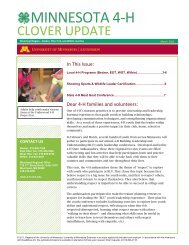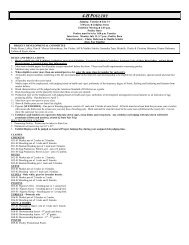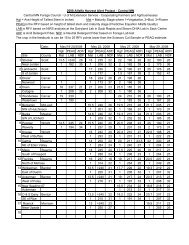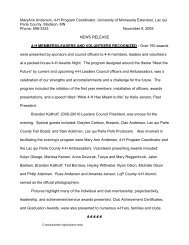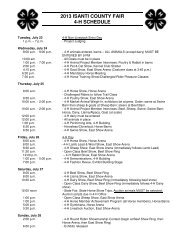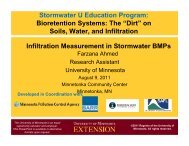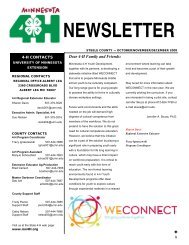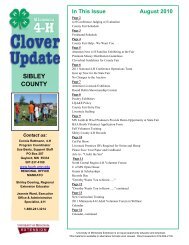Common Diseases of the Beef Cattle Herd - University of Minnesota ...
Common Diseases of the Beef Cattle Herd - University of Minnesota ...
Common Diseases of the Beef Cattle Herd - University of Minnesota ...
Create successful ePaper yourself
Turn your PDF publications into a flip-book with our unique Google optimized e-Paper software.
Biosecurity, Antibiotic Use, and <strong>Beef</strong> Quality Assurance<br />
Lori Weddle-Schott<br />
<strong>University</strong> <strong>of</strong> <strong>Minnesota</strong> <strong>Beef</strong> Team<br />
Brian Waddingham<br />
Iowa <strong>Beef</strong> Industry Council<br />
Lesson 4<br />
Introduction<br />
A biosecurity program is like an insurance policy for <strong>the</strong> health and productivity <strong>of</strong> <strong>the</strong><br />
herd. It may be not be cheap nor easy develop and implement but <strong>the</strong> protection it<br />
provides your herd is priceless. The first step is for producers to make decisions about<br />
<strong>the</strong>ir “risk tolerance level” based on <strong>the</strong> chances <strong>of</strong> a disease occurring and <strong>the</strong><br />
expected economic losses from <strong>the</strong> disease. Producers can <strong>the</strong>n implement <strong>the</strong><br />
appropriate level <strong>of</strong> risk management.<br />
There is no “one size fits all” program for biosecurity. Producers must learn about <strong>the</strong><br />
variety <strong>of</strong> tools and methods available and select those that best suit your operation and<br />
provide <strong>the</strong> adequate level <strong>of</strong> control for <strong>the</strong> many infectious diseases that can<br />
jeopardize <strong>the</strong> pr<strong>of</strong>itability and future <strong>of</strong> your cattle operation. All <strong>of</strong> <strong>the</strong> tools can be<br />
adapted to your individual objectives regardless <strong>of</strong> <strong>the</strong> size or scope <strong>of</strong> <strong>the</strong> operation.<br />
Development <strong>of</strong> <strong>the</strong> plan is not <strong>the</strong> final step; <strong>the</strong>re must be planning, commitment and<br />
education <strong>of</strong> all personnel throughout <strong>the</strong> operation to attain <strong>the</strong> goals set for an<br />
effective infectious disease control (biosecurity) program. With <strong>the</strong> stakes so high,<br />
biosecurity should be a very high priority in day to day management decisions.<br />
Biosecurity Basics<br />
Prevention is less costly than treatment.<br />
Biosecurity is defined as an infectious disease control program that will prevent or limit<br />
<strong>the</strong> introduction <strong>of</strong> new disease on <strong>the</strong> farm, as well as limit or prevent <strong>the</strong> spread <strong>of</strong><br />
disease within <strong>the</strong> operation. Biosecurity encompasses many different on-<strong>the</strong>-farm<br />
components. <strong>Cattle</strong> health, visitors, vehicles traffic, receiving replacement cattle,<br />
feedstuffs, animal identification and rendering practices all have a role in a biosecurity<br />
plan.<br />
Biosecurity management practices are designed to prevent <strong>the</strong> spread and movement<br />
<strong>of</strong> infectious diseases onto <strong>the</strong> operation. The goal <strong>of</strong> a biosecurity plan is to minimize<br />
<strong>the</strong> movement <strong>of</strong> biologic organisms and <strong>the</strong>ir vectors (dogs, cats, rodents, birds, etc.)<br />
onto and within your cattle operation. While developing and implementing biosecurity is<br />
difficult, it is <strong>the</strong> cheapest, most effective means <strong>of</strong> disease control available, and no<br />
disease prevention program will work without it.<br />
1<br />
Biosecurity, Antibiotic Use, and <strong>Beef</strong> Quality Assurance Lesson 4
The possibilities <strong>of</strong> agroterrorism attacks on <strong>the</strong> U.S. livestock industry, including <strong>the</strong><br />
introduction <strong>of</strong> foreign animal disease, are real. <strong>Beef</strong> producers need to keep informed<br />
about this threat and how to implement biosecurity plans measures into <strong>the</strong>ir operations<br />
to prevent <strong>the</strong> spread <strong>of</strong> disease. These same measures will protect <strong>the</strong> livestock on<br />
<strong>the</strong> operation from more common animal diseases that can impact your bottom-line.<br />
Intentional introduction a foreign animal disease into <strong>the</strong> U.S. would not be terribly<br />
difficult, according to <strong>of</strong>ficials at <strong>the</strong> Department <strong>of</strong> Homeland Security. It is <strong>the</strong>refore<br />
very important for producers, veterinarians and o<strong>the</strong>rs involved in <strong>the</strong> field <strong>of</strong> agriculture<br />
to become familiar with <strong>the</strong> issues surrounding agroterrorism. Biosecurity is <strong>the</strong> first<br />
one <strong>of</strong> <strong>the</strong> first lines <strong>of</strong> defense against an attack on <strong>the</strong> livestock industry, particularly at<br />
<strong>the</strong> producer level.<br />
Intentional introduction <strong>of</strong> a foreign animal disease could cripple <strong>the</strong> economy, induce<br />
fear and panic among consumers, close export markets, or cause disease and death in<br />
animals and humans. It has been stated that one in six jobs in America is related to<br />
agriculture in some manner. <strong>Beef</strong> production is <strong>the</strong> single largest segment <strong>of</strong> <strong>the</strong><br />
agricultural industry, accounting for 1.4 million jobs and $188.4 billion dollars <strong>of</strong> direct<br />
and indirect economic activity. Moreover, beef cattle are produced in all 50 states and<br />
thus have an impact on all state and local economies.<br />
Infectious diseases can be spread between operations by:<br />
The introduction <strong>of</strong> diseased cattle or healthy cattle incubating <strong>the</strong> disease.<br />
The introduction <strong>of</strong> healthy cattle that have recovered from disease but are now<br />
carriers.<br />
Vehicles, equipment, clothing and shoes <strong>of</strong> visitors or employees who move<br />
between herds.<br />
Contact with inanimate objects contaminated with disease organisms.<br />
Carcasses <strong>of</strong> dead cattle that have not been disposed <strong>of</strong> properly.<br />
Feedstuffs, especially high risk feedstuffs, which could be contaminated with<br />
feces.<br />
Manure hauling equipment.<br />
Exposure to horses, dogs, cats, wildlife.<br />
2<br />
Biosecurity, Antibiotic Use, and <strong>Beef</strong> Quality Assurance Lesson 4
Developing your biosecurity plan. A biosecurity plan has three major components.<br />
They are isolation, traffic control and sanitation. When effectively managed, <strong>the</strong>se<br />
components meet <strong>the</strong> principle biosecurity objectives <strong>of</strong> preventing or minimizing cross<br />
contamination <strong>of</strong> body fluids (feces and urine) between animals, animals to feed and<br />
animals to equipment.<br />
1. Isolation prevents contact between animals within a controlled environment.<br />
The most important step in disease control is to minimize commingling and<br />
movement <strong>of</strong> cattle. This includes isolation <strong>of</strong> new purchases for at least 3<br />
weeks as well as commingling between established groups <strong>of</strong> cattle. Always<br />
isolate sick cattle and return <strong>the</strong>m to <strong>the</strong>ir original group when <strong>the</strong>y’ve recovered.<br />
Clean and disinfect facilities appropriately between groups. Is also means<br />
isolating higher risk cattle, like purchased feedlot cattle, from lower risk cattle, like<br />
<strong>the</strong> breeding herd and young calves. Contact can occur through <strong>the</strong> fence, same<br />
handling facilities, or drainage from <strong>the</strong> feedlot through <strong>the</strong> pasture.<br />
2. Traffic control includes traffic and visitors onto your operation and traffic<br />
patterns within your operation. It is important to understand that traffic includes<br />
more than vehicles. All animals including dogs, cats, wildlife, horses, birds,<br />
rodents and people must be considered. People spread contamination material<br />
directly by boots, shoes, and hands and clothing. Disease can be spread<br />
indirectly by truck tires, farm machinery, hair clippers and o<strong>the</strong>r equipment<br />
passing between farms.<br />
3. Sanitation is <strong>the</strong> third component <strong>of</strong> a biosecurity plan. Beware <strong>of</strong> using<br />
instruments and equipment on healthy animals following <strong>the</strong>ir use on sick or<br />
infected animals. Avoid using common syringes and needles for vaccinating,<br />
blood testing or administering animal health products. Isolate sick animals,<br />
especially animals with unfamiliar symptoms or those that don’t get better with<br />
<strong>the</strong> usual treatment.<br />
Improving an animal’s disease resistance is at <strong>the</strong> heart <strong>of</strong> disease prevention and herd<br />
health programs and must be considered in <strong>the</strong> standard operating procedures <strong>of</strong> all<br />
livestock production management. However, improving disease resistance is not<br />
possible for many <strong>of</strong> <strong>the</strong> diseases that can affect livestock health and production.<br />
Therefore an understanding <strong>of</strong> biosecurity basics is essential for a properly designed<br />
disease resistance health program.<br />
Commitment to a biosecurity plan is a vital step toward control <strong>of</strong> infectious disease.<br />
Keeping pathogens out <strong>of</strong> a herd improves production efficiency, lowers costs and<br />
reduces risk to family and employees.<br />
3<br />
Biosecurity, Antibiotic Use, and <strong>Beef</strong> Quality Assurance Lesson 4
Biosecurity Practices/<strong>Herd</strong> Health Program Protocol for Controlling Disease<br />
Vaccinate <strong>the</strong> herd against all endemic diseases.<br />
Use low stress management practices during movement and processing.<br />
Isolate all sick animals- designate a hospital pen.<br />
Work from younger or healthier animals to older higher risk animals.<br />
Maintain a closed herd, if possible.<br />
Know <strong>the</strong> health history <strong>of</strong> incoming animals.<br />
Purchase feed from reputable sources.<br />
Minimize fence line contact with neighboring animals.<br />
Do not place cattle <strong>of</strong> different ages in <strong>the</strong> same pen.<br />
Keep records <strong>of</strong> all disease occurrences and treatments.<br />
Limit access to your farm.<br />
Maintain fences to keep your animals in and o<strong>the</strong>rs out.<br />
Minimize visitors and traffic on your farm.<br />
Post signs at <strong>the</strong> farm entrance to inform visitors <strong>of</strong> procedures to follow.<br />
Educate yourself and employees to recognize and report diseases.<br />
Maintain a written biosecurity plan and update it regularly.<br />
Prevent <strong>of</strong>f-farm vehicles from driving in areas where animals travel.<br />
Individually identify every animal.<br />
Monitor and inspect animals daily for signs <strong>of</strong> illness.<br />
Clean equipment, boots and change clothing between animal groups with different<br />
health status.<br />
Promptly euthanize animals that are not going to recover.<br />
Have your vet necropsy animals that die from unknown causes.<br />
Promptly remove dead animals from your operation.<br />
Place animal delivery and load-out facilities on <strong>the</strong> perimeter <strong>of</strong> your farm.<br />
4<br />
Biosecurity, Antibiotic Use, and <strong>Beef</strong> Quality Assurance Lesson 4
Attached at <strong>the</strong> end <strong>of</strong> this lesson you will find <strong>the</strong> “Biosecurity Best Management<br />
Practices Checklist” developed by <strong>the</strong> Iowa <strong>Beef</strong> Council. How does your Biosecurity<br />
Plan Rate? Complete <strong>the</strong> Checklist and find out. (It will be a test question.)<br />
Antibiotic Use in <strong>Cattle</strong> Production<br />
What are antibiotics? Antibiotics, also known as antimicrobials, are medications that<br />
fight infections caused by bacteria. Antibiotics made specifically for cattle are used to<br />
help an animal regain or maintain superior health and produce safe beef. Antibiotics<br />
can prevent infection when bacterial pathogens are suspected or known to be in <strong>the</strong><br />
animal’s environment or when an animal encounters high-stress situations that can<br />
increase its susceptibility to illness. Antibiotics used in beef cattle must go through a<br />
rigorous testing process before being approved by <strong>the</strong> FDA to assure <strong>the</strong> safety <strong>of</strong> cattle<br />
as well as beef products entering <strong>the</strong> food supply.<br />
Avoiding antibiotic residues. The beef industry is doing an excellent job <strong>of</strong> controlling<br />
violative drug residues in our meat products. Improvements have occurred by educating<br />
producers on <strong>the</strong> importance <strong>of</strong> identification and handling <strong>of</strong> individually treated<br />
animals. Producers need to remember that identifying each animal treated, accurately<br />
recording <strong>the</strong> treatment, date and treatment dose, as well as strictly following prescribed<br />
withdrawal times. You need to have a working relationship with a licensed veterinarian.<br />
Producers need to be aware that taking advice from anyone who is NOT highly<br />
acquainted with your operation and <strong>the</strong> proper use <strong>of</strong> animal health products could<br />
jeopardize your operation and livestock.<br />
Guidelines for prudent use <strong>of</strong> antibiotics. The American Veterinary Medical<br />
Association (AVMA), Food and Drug Administration (FDA), and various veterinary<br />
practice groups and beef quality assurance programs have developed <strong>the</strong> following<br />
guidelines for use <strong>of</strong> antibiotics in livestock. These guidelines are based on providing<br />
<strong>the</strong> best care for <strong>the</strong> animal and at <strong>the</strong> same time protecting public health.<br />
Often it is <strong>the</strong> beef producer who decides how antibiotics will be used. Anyone who<br />
administers antibiotics to animals should understand and be willing to apply <strong>the</strong>se<br />
general concepts <strong>of</strong> use <strong>of</strong> antibiotics.<br />
1. Provide a system <strong>of</strong> care to prevent common diseases<br />
It is more cost effective to prevent disease ra<strong>the</strong>r than rely upon antibiotics to treat<br />
disease once it has developed. Minimizing disease risk on your operation is a<br />
necessity for any sound production system and is achieved by maintaining sanitation<br />
and hygiene, providing high quality feed, providing protection from <strong>the</strong> elements,<br />
implementing biosecurity measures, performing regular health exams and using<br />
vaccines and parasite control.<br />
2. When animals do get sick, have an accurate diagnosis<br />
This ensures antibiotics will be used to treat <strong>the</strong> appropriate symptoms. Diagnosing<br />
an animal’s condition should be based on: clinical signs, history, necropsy results,<br />
5<br />
Biosecurity, Antibiotic Use, and <strong>Beef</strong> Quality Assurance Lesson 4
lab data, and <strong>the</strong> evaluation <strong>of</strong> <strong>the</strong> herd health history. Rely on your vet for an<br />
accurate diagnosis.<br />
Determine if antibiotics are <strong>the</strong> most appropriate option. Consider <strong>the</strong> treatment<br />
outcomes you want for <strong>the</strong> animal and what types <strong>of</strong> <strong>the</strong>rapy will help you achieve <strong>the</strong>m.<br />
Will an antibiotic provide <strong>the</strong> results you want? Will <strong>the</strong> animal’s condition even respond<br />
to antibiotics? Does <strong>the</strong> animal need ano<strong>the</strong>r type <strong>of</strong> <strong>the</strong>rapy? Will using antibiotics be<br />
<strong>the</strong> most economically sound treatment?<br />
Choose <strong>the</strong> most appropriate antibiotic for <strong>the</strong> situation. Not all antibiotics work <strong>the</strong><br />
same and each drug acts against different types <strong>of</strong> bacterial infections. Culture test <strong>of</strong><br />
organisms will help determine <strong>the</strong> type <strong>of</strong> antibiotic most effective in clearing <strong>the</strong><br />
infection. Select an antibiotic that can be easily administered and will result in effective<br />
concentrations reaching <strong>the</strong> site <strong>of</strong> <strong>the</strong> infection. When appropriate, use local <strong>the</strong>rapy<br />
instead <strong>of</strong> systemic. Use only medications approved for <strong>the</strong> use you intend.<br />
Work with your veterinarian to enhance your options. Vets have <strong>the</strong> knowledge<br />
and resources necessary to determine <strong>the</strong> most effective <strong>the</strong>rapy. Your veterinarian<br />
can <strong>of</strong>fer valuable guidance for <strong>the</strong> use <strong>of</strong> over-<strong>the</strong>-counter antibiotics and, within <strong>the</strong><br />
context <strong>of</strong> a valid “Vet-Client-Patient Relationship” can <strong>of</strong>fer enhanced <strong>the</strong>rapy through<br />
<strong>the</strong> use <strong>of</strong> prescription and extra-label use medications. You must establish a valid<br />
VCPR with your veterinarian before receiving drug prescriptions or using an antibiotic<br />
any way o<strong>the</strong>r than exactly as labeled. Your veterinarian may provide written protocols<br />
for diagnosing and treating commonly disease conditions.<br />
Use antibiotics and o<strong>the</strong>r medications as ordered. THE LABEL IS THE LAW. You<br />
must use medications at <strong>the</strong> ordered dosage for <strong>the</strong> animal.<br />
1) If <strong>the</strong>re is not a suitable product for <strong>the</strong> condition, <strong>the</strong>n consult your veterinarian<br />
about using a product extra-label.<br />
2) Follow <strong>the</strong> new instructions outlined by your veterinarian for <strong>the</strong> extra-label use<br />
and pay particular attention to <strong>the</strong> revised withdrawal times.<br />
3) These times may be longer that <strong>the</strong> labeled withdrawal times because <strong>of</strong> <strong>the</strong><br />
modified usage <strong>of</strong> <strong>the</strong> antibiotic.<br />
4) Pay attention to quality assurance guidelines to protect against drug residues.<br />
5) Train all family members and personnel involved with antibiotic use and disease<br />
symptoms, dosages, routes <strong>of</strong> administration, proper injection techniques,<br />
treatment duration, withdrawal times, storage, handling, record keeping, and<br />
accurate diagnosis <strong>of</strong> diseases common for your operation.<br />
Treat <strong>the</strong> appropriate animals. Limit <strong>the</strong> <strong>the</strong>rapeutic antibiotic treatment to those<br />
animals that are sick or are legitimately at-risk <strong>of</strong> becoming sick. Avoid prolonged<br />
treatment <strong>of</strong> animals and consider <strong>the</strong> alternatives for chronic cases or those with a<br />
poor chance <strong>of</strong> recovery.<br />
6<br />
Biosecurity, Antibiotic Use, and <strong>Beef</strong> Quality Assurance Lesson 4
Store antibiotics and o<strong>the</strong>r medications appropriately. Drug integrity is maintained<br />
by following <strong>the</strong> label and veterinarian instructions for proper handling, storage and<br />
observations <strong>of</strong> expiration dates. Mistakes in administering <strong>the</strong> wrong medication are<br />
less likely if drugs are clearly labeled and stored in <strong>the</strong> appropriate places.<br />
Minimize environmental contamination. Dispose <strong>of</strong> outdated medications according<br />
to label directions or veterinary advice. Use disposal methods that minimize<br />
contamination <strong>of</strong> soil and water supplies. Provide feed and water medication delivery<br />
so that <strong>the</strong>re is minimal spillage into <strong>the</strong> environment.<br />
Use records to track treatment and evaluation outcomes. Keep accurate, detailed,<br />
and current records <strong>of</strong> antibiotics treatments and outcomes. Identify all animals ei<strong>the</strong>r<br />
by individual, pen, or lot so <strong>the</strong>y may be monitored. Treatment records should include<br />
<strong>the</strong> identity <strong>of</strong> animals treated, dates treated, drugs administered, who administered <strong>the</strong><br />
drugs, <strong>the</strong> amount administered, and withdrawal times.<br />
Treatment Protocol Book. <strong>Beef</strong> producers should work with <strong>the</strong>ir veterinarians to<br />
develop a Treatment Protocol Book specific to <strong>the</strong> operation. The Treatment<br />
Protocol Book should be reviewed regularly and updated as <strong>of</strong>ten as appropriate<br />
(record if new products are used, treatment outcomes, etc.). One copy <strong>of</strong> <strong>the</strong><br />
Treatment Protocol Book should be kept near your working facilities, while <strong>the</strong> o<strong>the</strong>r<br />
copy should be on file in your <strong>of</strong>fice. As you update your book, copies <strong>of</strong> past treatments<br />
should be kept on file for a year or more, so that you have a log <strong>of</strong> what did not work<br />
and what did. These written treatment protocol, along with current prescriptions are<br />
important documents that <strong>the</strong> beef operation must have if <strong>the</strong>re is a government<br />
inspection <strong>of</strong> <strong>the</strong> beef operation facilities, review <strong>of</strong> drug usage procedures or <strong>the</strong><br />
development <strong>of</strong> residue avoidance plans. Of greater significance, <strong>the</strong> treatment book<br />
provides written guidelines for your animal health programs, thus minimizing chances <strong>of</strong><br />
mistakes or misunderstandings.<br />
<strong>Beef</strong> Quality Assurance (BQA)<br />
“BQA is a process <strong>of</strong> figuring out what could go wrong, planning to avoid it, <strong>the</strong>n<br />
validating and documenting what you have done. BQA is just part <strong>of</strong> good business.”<br />
Dee Griffin, DVM-<strong>University</strong> <strong>of</strong> Nebraska<br />
The <strong>Beef</strong> Quality Assurance (BQA) program can be an extremely useful tool in <strong>the</strong><br />
creation <strong>of</strong> your biosecurity plan. Most producers think BQA just teaches producer how<br />
to give injections properly to cattle, but <strong>the</strong> program encompasses much more. BQA<br />
addresses many facets <strong>of</strong> <strong>the</strong> cattle industry such as nutrition, pesticide, animal welfare,<br />
traceability, herd health, industry trends, consumer trends and <strong>the</strong> importance <strong>of</strong> record<br />
keeping. The records keeping template and concepts presented in <strong>the</strong> BQA program<br />
can be <strong>the</strong> corner post <strong>of</strong> a solid biosecurity plan.<br />
7<br />
Biosecurity, Antibiotic Use, and <strong>Beef</strong> Quality Assurance Lesson 4
BQA record keeping. Record keeping, ei<strong>the</strong>r computer or hand generated, is a critical<br />
management tool and is a substantial part <strong>of</strong> any biosecurity plan. The original purpose<br />
<strong>of</strong> <strong>Beef</strong> Quality Assurance was to ensure consumer confidence and maintain market<br />
share. The thoroughness <strong>of</strong> <strong>the</strong>se records allows us to document <strong>the</strong> safety <strong>of</strong> our<br />
product while proving effective documentation over risk factors that have <strong>the</strong> potential to<br />
damage and even destroy your herd.<br />
Records are very important to business success. Regulatory inspections by FDA,<br />
USDA, EPA or OSHA will prove <strong>the</strong> necessity <strong>of</strong> good records. Effective documentation<br />
that shows appropriate compliance and documentation with animal sale and movement<br />
records, inventory control list, animal identification logs, drug withdrawal times, and<br />
animal disposal may help to limit or avoid liability from a residue contamination.<br />
Computer record systems make extensive evaluation easy and efficient; however,<br />
hand-kept record systems are still very effective. Each system has its own merits and<br />
you should select <strong>the</strong> system that is <strong>the</strong> most feasible for your beef operation. All<br />
records must be kept for a minimum <strong>of</strong> two years and up to ten years in <strong>the</strong> case<br />
<strong>of</strong> animal movement records. Samples <strong>of</strong> record keeping documents are attached at<br />
<strong>the</strong> end <strong>of</strong> this lesson.<br />
How do I become a BQA certified producer? <strong>Cattle</strong> producers can become BQA<br />
certified when <strong>the</strong>y meet criteria for quality beef production set forth in BQA guidelines.<br />
Most states have individual BQA programs and <strong>of</strong>fer <strong>the</strong>ir own certification standards.<br />
To find out more information on how to become a <strong>Beef</strong> Quality Assurance producer<br />
contact your state beef council or university extension beef specialist. The BQA<br />
program is developed for all beef producers without regard to membership in a<br />
cattlemen’s association.<br />
8<br />
Biosecurity, Antibiotic Use, and <strong>Beef</strong> Quality Assurance Lesson 4
References and Supplemental Readings<br />
Lane, C., Hopkins, F., Welborn, M., Palmer, G. 2006. Biosecurity for <strong>the</strong> <strong>Beef</strong> <strong>Herd</strong>.<br />
<strong>University</strong> <strong>of</strong> Tennessee Extension SP691.<br />
Pederson, L. North Dakota <strong>Beef</strong> Quality Assurance Program. Bismarck, ND.<br />
Smith, Leslie. 2004. The BQA Buzz. American Gelbvieh Association.<br />
Waddingham, B. 2007. Biosecurity Basics for <strong>Cattle</strong> Producers. Iowa <strong>Beef</strong> Industry<br />
Council.<br />
Guidelines for Prudent Use <strong>of</strong> Antibiotics. 2002. Department <strong>of</strong> Health and Human<br />
Services, Public Health, Food and Drug Administration, Center for Veterinary<br />
Medicine.<br />
American Veterinary Medical Association: www.avma.org<br />
Food and Drug Administration-Center for Veterinary Medicine (FDA-CVM):<br />
http://www.fda.gov/cvm/default.html<br />
Food Safety Inspection Service: http://fsis.usda.gov/index.htm<br />
Iowa <strong>Beef</strong> Council, Ames, IA www.iabeef.org<br />
<strong>Minnesota</strong> <strong>Beef</strong> Council, Bloomington, MN www.mnbeef.org<br />
National <strong>Cattle</strong>men’s <strong>Beef</strong> Association, <strong>Beef</strong> Quality Assurance, www.bqa.org<br />
Texas <strong>Beef</strong> Quality Producer Program, www.texasbeef.org<br />
9<br />
Biosecurity, Antibiotic Use, and <strong>Beef</strong> Quality Assurance Lesson 4
Notes<br />
10<br />
Biosecurity, Antibiotic Use, and <strong>Beef</strong> Quality Assurance Lesson 4
True or False<br />
Lesson 4 Quiz<br />
Biosecurity, Antibiotic Use and <strong>Beef</strong> Quality Assurance<br />
1. Prevention is more costly than treatment.<br />
2. Carcasses <strong>of</strong> dead cattle that have not been disposed <strong>of</strong> properly can spread infectious<br />
diseases.<br />
3. Culture test <strong>of</strong> organisms will help determine <strong>the</strong> type <strong>of</strong> antibiotic most effective in<br />
clearing <strong>the</strong> infection.<br />
4. The antibiotic/drug label is <strong>the</strong> law.<br />
5. A Treatment Protocol Book is an important document if a drug residue occurred in one <strong>of</strong><br />
your market cows.<br />
6. Records should be written on old feed sacks, <strong>the</strong> barn wall, or <strong>the</strong> palm <strong>of</strong> your hand.<br />
7. It is advised that all BQA records be kept for a minimum <strong>of</strong> two months and up to ten<br />
years for animal movement records.<br />
8. The BQA Program is developed for only beef producers in a cattlemen’s association.<br />
9. What was your score on <strong>the</strong> “Biosecurity Best Management Checklist”? (<strong>the</strong> Biosecurity Best<br />
Management Checklist is included in <strong>the</strong> reference materials with this lesson)<br />
10. List 5 things you will do to improve biosecurity on your operation?<br />
PLEASE SEND YOUR QUIZ TO YOUR ASSIGNED GRADER UPON COMPLETION<br />
Name_______________________________________ Phone _________________________<br />
Address_____________________________________________________________________<br />
Fax (Optional)_________________________ Email (Optional)__________________________<br />
11<br />
Biosecurity, Antibiotic Use, and <strong>Beef</strong> Quality Assurance Lesson 4
This lesson was prepared by:<br />
2008 <strong>Minnesota</strong> <strong>Beef</strong> Home Study Course<br />
Ms. Lori Weddle-Schott<br />
Extension Educator, <strong>Beef</strong><br />
<strong>University</strong> <strong>of</strong> <strong>Minnesota</strong> Extension<br />
2008 Mahogany Street, Suite 2<br />
Mora, MN 55051<br />
Phone 320-225-5055<br />
Email weddl002@umn.edu<br />
Mr. Brian Waddingham<br />
Director <strong>of</strong> Industry Relations and Collection Compliance<br />
Iowa <strong>Beef</strong> Industry Council<br />
P.O. Box 451<br />
Ames, IA 50010<br />
Phone 515-296-2305<br />
Email brian@iabeef.org<br />
For more information on beef-related topics, visit <strong>the</strong> U <strong>of</strong> M <strong>Beef</strong> Team website:<br />
www.extension.umn.edu/beef<br />
12<br />
Biosecurity, Antibiotic Use, and <strong>Beef</strong> Quality Assurance Lesson 4




